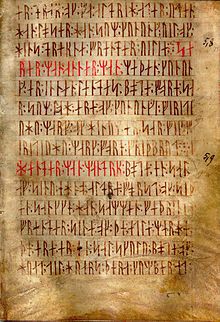| Medieval runes | |
|---|---|
 Leaf (f. 27r.) of Codex Runicus, a vellum manuscript from c. 1300 containing one of the oldest and best preserved texts of the Scanian Law, written entirely in runes | |
| Script type | alphabet
|
Time period | 12th to 17th centuries |
| Direction | Left-to-right |
| Languages | North Germanic languages |
| Related scripts | |
Parent systems | |
Child systems | Dalecarlian runes |
The medieval runes, or the futhork, was a Scandinavian runic alphabet that evolved from the Younger Futhark after the introduction of stung (or dotted) runes at the end of the Viking Age. These stung runes were regular runes with the addition of either a dot diacritic or bar diacritic to indicate that the rune stood for one of its secondary sounds (so an i rune could become an e rune or a j rune when stung). The medieval futhork was fully formed in the early 13th century. Due to the expansion of its character inventory, it was essentially possible to have each character in an inscription correspond to only one phoneme, something which was virtually impossible in Younger Futhark with its small inventory of 16 runes.[1]
Medieval runes were in use throughout Scandinavia during the Middle Ages, and provided the basis for runology beginning in the 16th century.
- ^ Enoksen 1998:137
